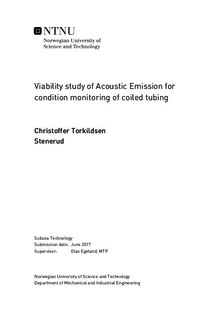Viability study of Acoustic Emission for condition monitoring of coiled tubing
Master thesis
Permanent lenke
http://hdl.handle.net/11250/2453826Utgivelsesdato
2017Metadata
Vis full innførselSamlinger
Sammendrag
Acoustic emission refers to the dispersal of elastic waves generated by crack initiation and other damaging mechanisms within a material. Recording and analyzing these waves form the foundation of the monitoring technique called Acoustic Emission (AE). The method is widely used in areas such as material research and structural inspection. Furthermore, the method is showing great theoretical and practical promise within the field of fatigue crack monitoring.
In this thesis, the viability of using acoustic emission monitoring for coiled tubing applications is studied through an extensive literature review. The need for fatigue crack monitoring is identified by studying the most influential failure modes as well as the existing inspection technology for coiled tubing. This is followed by identifying potential benefits and challenges of implementing acoustic emission for this purpose, as well as a proposed solution.
Additionally, practical tensile and fatigue cracking tests were conducted on low carbon steel using acoustic emission to monitor damaging processes within the material. The monitoring equipment was provided by ClampOn was a reconfigured sand particle monitoring system and the purpose of the tests was to evaluate the equipment s AE performance. From the test results, it was possible to conclude that the equipment demonstrated an excellent ability to detect acoustic emission generated from the initiation and propagation of fatigue cracks. However, limitations such as lack of frequency filtering and distinction made signal analysis problematic when faced with continuous noise from the hydraulic test rig.
